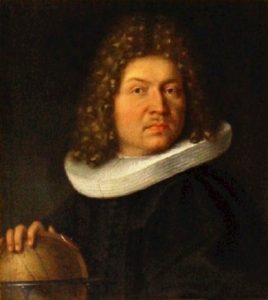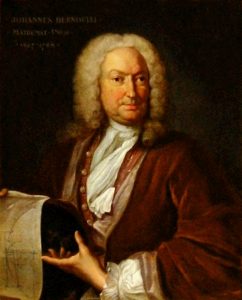
The Bernoullis are undoubtedly the most famous family saga in the history of mathematics, some of its members being among the great mathematicians of the last third of the 17th century and the whole of the 18th century. The founders of the saga were the brothers Jakob and Johann Bernoulli.
The eldest of them, Jakob Bernoulli, was born in Basel in early 1655 into a prosperous family of merchants, Flemish refugees who emigrated from Flanders to Switzerland in the mid-16th century to escape religious persecution and the war between Spain and the Netherlands. Against the wishes of his father, who wanted him to study theology, Jakob decided in favour of mathematics and astronomy, and made this decision his life’s motto: Invito patre sidera verso – Against my father’s wishes I study the stars. In 1687 he got a seat at the University of Basel. He studied the works of Wallis, Barrow, Descartes and Leibniz. From the latter he learned infinitesimal calculus, becoming, together with his brother Johann, key figures in its development, refinement and expansion. He also made important contributions to probability. He died in 1705 in Basel. Emulating Archimedes, he wanted to have a logarithmic spiral engraved on his tombstone with the inscription Eadem mutata resurgo – Even if modified, I am invariant – which emphasised the remarkable properties of invariance of this curve that Jakob had discovered.

Born in 1667, Johann Bernoulli studied medicine at the University of Basel, but, like his brother, and to his father’s sorrow, he soon changed his studies to mathematics. His brother taught him infinitesimal calculus; and, for his part, during a stay in Paris in 1692, he taught it to a French nobleman, the Marquis de L’Hôpital. According to Johann himself, the Marquis was a good mathematician, but at the time he knew nothing about the newly created calculus. Apparently, the Marquis was very proud of a method he had developed for calculating the curvature of an algebraic curve at some particular points. At one of their first meetings, the marquis showed his method to Johann Bernoulli, who proposed an example as a test. It took the Marquis about an hour to solve Bernoulli’s simple example. To illustrate the enormous power of the new calculation, Bernoulli showed him how in a few minutes he could find the curvature of a generic curve at any one of its points, and to compare the two methods he proposed as an example a curve that was beyond the possibilities of the Marquis’s method. “It gave him so much surprise,” Bernoulli later explained, “that from that moment the marquis was enchanted by the new analysis of the infinitely small and enthusiastic about learning it from me”. The product of these teachings was the first book published on Leibniz’s calculus; it appeared under the title Analyse des infiniment petits and under the authorship of the Marquis, who had reached a financial agreement with Johann Bernoulli to use the latter’s discoveries. This book contains Bernoulli’s result that we know today as L’Hopital’s rule.
From 1695 to 1705, Johann Bernoulli taught mathematics at the Dutch university of Groningen. On the death of his brother in 1705, he took over his brother’s position in Basel, and shortly afterwards gave private lessons to the young Leonhard Euler – Johann was a friend of Euler’s father.
Johann Bernoulli had a strong personality and temperament. He famously took part in the dispute over the priority of the discovery of the infinitesimal calculus on Leibniz’s side, especially for the foul play he played, which included furious attacks on Newton made anonymously or in private letters addressed to Leibniz, while publicly or in letters to Newton or his followers he poured almost drooling praise on the English genius. He also famously quarrelled with other members of his family, especially his brother Jakob and his son Daniel. “Some of his mathematical letters,” wrote E.T. Bell, “are bristling with the rough language usually reserved for horse thieves”. One such quarrel concerned the identification of the catenary. It was Jakob who proposed the problem in 1690 and, although he claimed to have solved it too, he did not publish his solution along with those he received from Leibniz, Huygens and Johann. The proud Johann did not miss the opportunity to deny it: “My brother’s efforts were unsuccessful,” Johann explained in a letter, years after Jakob’s death. “It is true that it took me a whole night to solve the problem, but the next morning, full of joy, I ran to my brother, who was still struggling miserably with this Gordian knot without getting anywhere, always thinking like Galileo that the catenary was a parabola. Stop, stop, I said to him, don’t torture yourself any more trying to prove that the catenary is a parabola, because it is entirely false. And then you stunned me by telling me that my brother had found a method to solve the problem. I ask you, do you really think that, if my brother had found a method of solving it, he would have been so condescending to me as not to appear among those who solved it, and give me the glory of appearing only as one of those who first solved it, next to Messrs Huygens and Leibniz?”.
Three of Johann Bernoulli’s sons were also mathematicians, the most famous of whom was Daniel Bernoulli (1700-1782); he made important contributions in hydrodynamics and elasticity, and was also a skilled experimental physicist who anticipated the law of attraction for electric charges – proportional to them and inversely proportional to the square of the distance.

His father had arranged for Daniel to go into business, but family tradition made him disobey his father and become a mathematician. In 1725 he won the Académie de Paris prize, and was subsequently recruited by the St Petersburg Academy, where his two brothers and Euler also ended up. Daniel did not like the Russian atmosphere, and returned to Basel in 1734, although this meant that he had to teach botany, and later physiology, for years. The year of his return he also had a monumental row with his father. They had both submitted papers on planetary orbits to the Académie de Paris; the quality of the two papers meant that the prize was shared. Johann was not at all happy about sharing the prize, not even with his son, who, in view of the poor economic prospects after his return from Russia, was living with his father, so that the irascible Johann simply expelled his son from home. Daniel had a different nature, and when he published Hydrodinamica, his most famous book, four years later, he introduced himself as “Daniel Bernoulli, son of Johann”.
References
A.J. Durán, Crónicas matemáticas, Crítica, Barcelona, 2018.

Leave a Reply